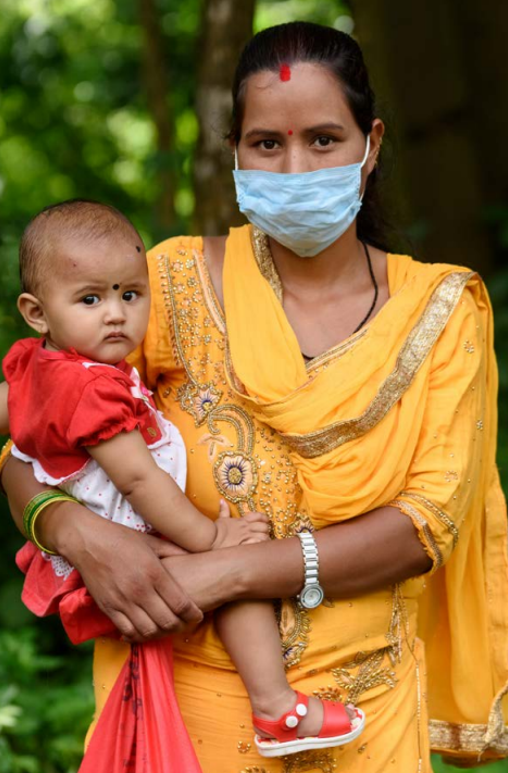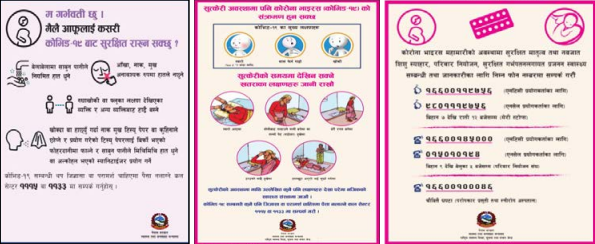.tmb-768v.png?Culture=en&sfvrsn=54737d84_1)
The critical role of the Reproductive Health Sub-cluster to maintain the delivery and use of essential RMNCAH* services in Nepal
Author
World Health Organization
This action brief is extracted from the series of key action briefs on “maintaining the provision and use of services for maternal, newborn, child and adolescent health and older people during the COVID-19 pandemic” published by the WHO Department of Maternal, Newborn ,Child and Adolescent Health and Ageing. To access the series, please click here.
This brief was developed using information collected from existing documents as well as information captured through discussions with key institutional stakeholders. The views in this brief do not necessarily represent the decisions, policy or views of the World Health Organization.
* Reproductive, maternal, newborn, child and adolescent health
Country
Nepal
Key learning points
• Regular meetings of the Reproductive Health Sub-cluster and discussions on continuity of services were key to prompt action and ensuring support to the provinces and local health facilities.
• From the outset of the pandemic and during the lockdown period, the continuity of essential RMNCAH services was prioritized by the RH sub-cluster.
• Proper planning and clarity of roles led to effective collaboration of the implementing partners, especially for those zones of the country where they were already working.
• The ability to coordinate and provide timely guidance and support to provincial and local governments was considered by the various stakeholders as a key factor in maintaining essential RMNCAH services.
• Access to data from the health management information system (HMIS) related to use of essential RMNCAH services, including data from districts, was essential to make decisions and take actions to maintain services.
• During the pandemic, the supply status for medicines and commodities was monitored through the use of an electronic logistics management system which was expanded to all 753 local municipalities (palikas).
Impact of COVID-19 on essential health services
In Nepal, the first case of COVID-19 was confirmed on 23 January 2020, and three waves of the pandemic were observed during 2020 to 2021. The pandemic brought challenges to every aspect of life: economic, social, political and administrative. The efforts to mitigate its impact were not clear as there was no past experience to deal with such a pandemic. The health sector was seriously affected and faced many challenges.

Actions to maintain essential services
Soon after the first COVID-19 case report, the Government of Nepal initiated various actions to address the challenges foreseen. The Health Emergency Cluster, formed during the earthquake of 2015, was reactivated, as subsequently was the Reproductive Health (RH) Sub-cluster (also formed during the earthquake), in March 2020. The cluster mechanism aimed to ensure a systematic response to the pandemic by engaging with multiple national and international partners.
The RH Sub-cluster engaged all relevant stakeholders to ensure continued delivery and use of essential RMNCAH services. The following actions were prioritized:
1. Development of interim guidelines to maintain essential RMNCAH services;
2. Training on the interim RMNCAH guidelines for health workers and facility managers;
3. Using data to monitor the interruption of RMNCAH services;
4. Information, education and communication (IEC) and behaviour change communication activities;
5. Logistics support for essential medicines and supplies.
Outcomes of implementation
Interim RMNCAH guidelines were developed to guide delivery of essential services at health facilities in the COVID-19 context. Subsequently virtual training courses were organized for health workers and some supervisors to ensure the uptake of the interim guidelines.
Key RMNCAH indicators to be monitored on a monthly basis were identified through the HMIS, and analysis was presented to the RH Sub-cluster. The information was used in making decisions about actions to be taken and was also communicated to the provinces and local palikas (municipalities) for action.
IEC and behavior change communication materials were developed and disseminated widely, both electronically and in print. Helplines were established to answer queries, especially about the reproductive health needs of women and adolescents during COVID-19 pandemic.
The RH Sub-cluster played a key role in coordination of different actors and different levels of the health system (including federal, provincial and local governments) to ensure implementation of prioritized actions. This was mainly achieved through regular weekly virtual meetings and phone calls.

From left to right: IEC materials on pregnancy and COVID-19 IEC poster on danger signs during pregnancy and COVID-19 IEC poster on RH Hotline numbers Credits: National Health Education, Information and Communication Center, Department of Heath Services, Ministry of Health and Population
Challenges
• Most of the attention of the broader Health Cluster was given to issues related to COVID-19 diagnosis, treatment, care and management, and less to RMNCAH issues.
• Frequent changes of the senior management affected the continuity of activities.
• Limited financial and human resources resulted in priority to urgent matters, like the COVID-19 vaccine programme.
• Bureaucratic procedures and administrative requirements often caused delays in the implementation of activities.
• Minimal action was taken on adolescent sexual and reproductive health, as well as to address the health of older people.
• Data on human resources was not readily available which affected accurate assessment of needs.

